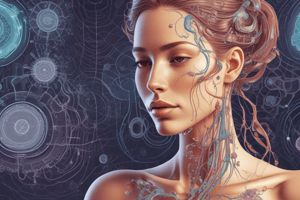Podcast
Questions and Answers
Where does spermatogenesis occur in the male reproductive system?
Where does spermatogenesis occur in the male reproductive system?
- Vas Deferens
- Epididymis
- Prostate Gland
- Testis (correct)
What is the function of the Fallopian Tubes in the female reproductive system?
What is the function of the Fallopian Tubes in the female reproductive system?
- Implant embryos
- Produce eggs
- Store mature eggs
- Facilitate fertilization (correct)
Which organ in the male reproductive system produces alkaline fluid to nourish and protect sperm postejaculation?
Which organ in the male reproductive system produces alkaline fluid to nourish and protect sperm postejaculation?
- Testis
- Epididymis
- Penis
- Prostate Gland (correct)
What is the role of the Urethra in the male reproductive system?
What is the role of the Urethra in the male reproductive system?
Where does ovulation occur in the female reproductive system?
Where does ovulation occur in the female reproductive system?
Flashcards are hidden until you start studying
Study Notes
Introduction
In biology, reproduction is the process by which new individual organisms come into existence, created from pre-existing parents through the fusion of gametes (sex cells). For humans, understanding the human reproductive system helps us appreciate the complexity involved in creating life. This article will discuss various aspects of human reproduction, including its stages, organs, hormones, and processes involved in fertilization and gestation.
Stages of Human Reproduction
Human reproduction can be divided into three main stages: growth and development, puberty, and sexual maturity:
-
Growth and Development: Until birth, a person's body goes through several stages of growth and development. After birth, these continue until they reach physical maturation. During this time, their body size increases significantly while also undergoing cell division to grow tissues and develop vital systems such as the heart and nervous system.
-
Puberty: Around the age of 12, both boys and girls experience changes associated with puberty. These changes occur due to the secretion of sex hormones produced by the hypothalamus, pituitary gland, testes, and ovaries. In females, the production of estrogen stimulates breast enlargement while increasing the thickness of the uterine lining; in males, testosterone causes the penis and scrotum to grow. Puberty marks the beginning of sexual maturity for individuals.
-
Sexual Maturity: Once one reaches full physical maturation, they are considered sexually mature. At this stage, men are capable of producing sperm and contributing to sexual intercourse, while women can produce eggs and become pregnant.
Organs of the Human Reproductive System
The human reproductive system consists of two sets of organs - male and female. Here we explore each set separately:
Male Reproductive System
- Testis: A tube containing millions of tiny coiled tubules called seminiferous tubules where spermatogenesis occurs—the formation and development of sperms. Spermatozoa mature within the epididymides before being stored in the vas deferens.
- Epididymis: A tightly coiled duct attached to the rear of each testicle where sperms mature and get stored temporarily.
- Vas Deferens: Two muscular tubes running like cords behind the bladder to deliver sperm from the epididymis to the urethra during ejaculation.
- Urethra: A tube that carries urine out of the body when one urinates and acts as a passageway for semen during ejaculation.
- Penis: An external organ that delivers semen into the vagina during sexual intercourse.
- Prostate Gland: Produces alkaline fluid that nourishes and protects sperm postejaculation.
- Bulbourethral (Cowper) Glands: Secrets mucus that clears debris from the penile canal prior to ejaculation.
Female Reproductive System
- Ovary: Contains many follicles, small sacs filled with immature egg cells (oocytes), which eventually release mature eggs upon reaching ovulation. Ova receive nutrition from nearby blood vessels and can live up to six months inside the body.
- Fallopian Tubes: Also known as uterine tubes, these serve as pathways for the movement of eggs released from the ovaries towards the uterus during ovulation. They also act as the site of fertilization if the egg meets sperm.
- Uterus: A hollow, pear-shaped organ located below the stomach in women, where embryos implant and fetuses grow. It has thick walls composed mainly of smooth muscle tissue to help it contract effectively during labor.
- Cervix: Situated between the upper part of the vagina and the opening to the uterus, it forms a narrow, lower end of the womb.
- Vagina: The internal canal leading from the vulva to the cervix, forming part of the female genital tract.
Hormonal Regulation of Human Reproduction
Reproduction relies heavily on hormones, which regulate growth, development, and maintenance functions in the male and female reproductive systems. Key hormones involved include:
- Follicle-Stimulating Hormone (FSH) and Luteinizing Hormone (LH): Initiate ovulation and spermatogenesis respectively.
- Estrogen and Progesterone: Prepare the uterine lining for implantation and maintain pregnancy.
- Androgens: Testosterone promotes masculinity in men, affects secondary sexual characteristics, and influences libido.
- Prolactin: Promotes lactation in females after childbirth.
Fertilization & Gestation
Fertilization is the union of a sperm cell and an egg, resulting in the creation of a zygote, the first cell of a new organism. Typically, fertilization takes place in the fallopian tubes, but in some cases, in vitro fertilization may be necessary. After fertilization, the developing embryo travels down the fallopian tubes and to the uterus, where it attaches itself to the wall via various molecules, a process known as implantation.
Once implanted, the growing fetus requires nutrients and oxygen, supplied primarily by the mother via the placenta, an organ formed from the fused walls of the maternal and embryonic tissues. The entire period of gestation lasts approximately 40 weeks, ending with the delivery of the baby.
Understanding how our bodies work together to create new life is crucial because it explains why people face difficulties conceiving naturally and what medical advances have allowed them to do to aid those who struggle with infertility.
Studying That Suits You
Use AI to generate personalized quizzes and flashcards to suit your learning preferences.




